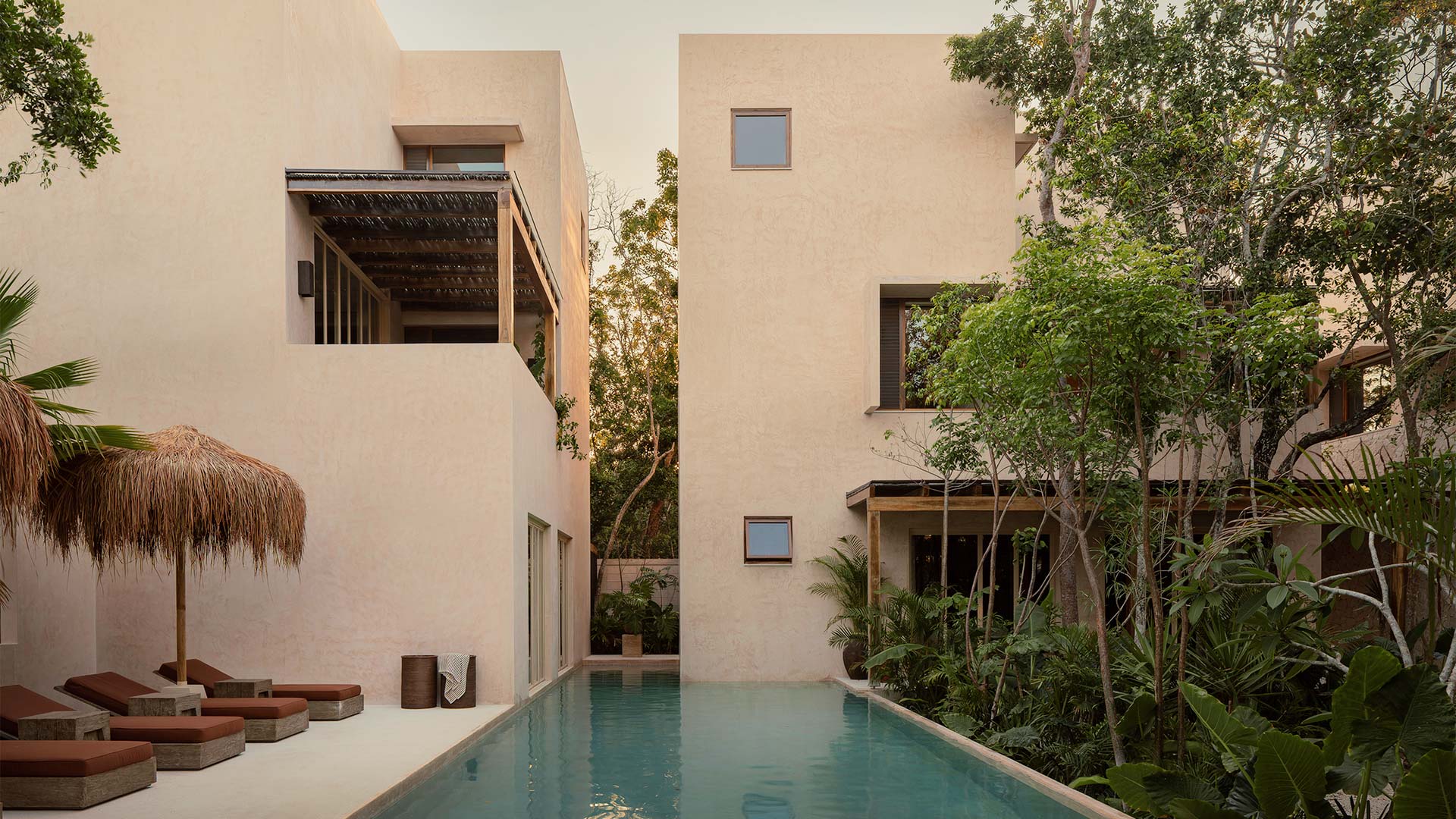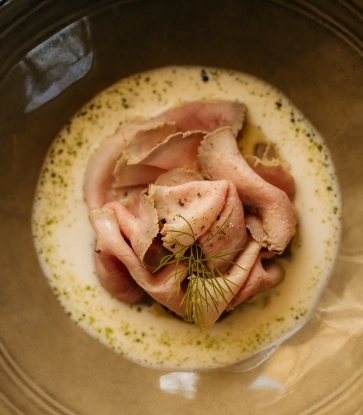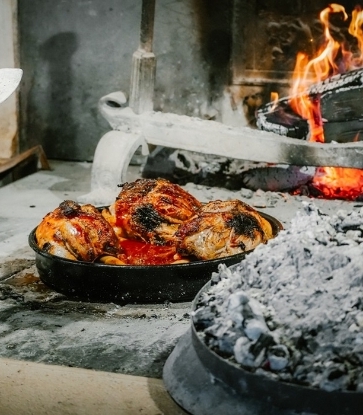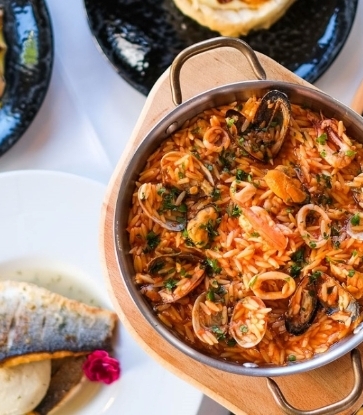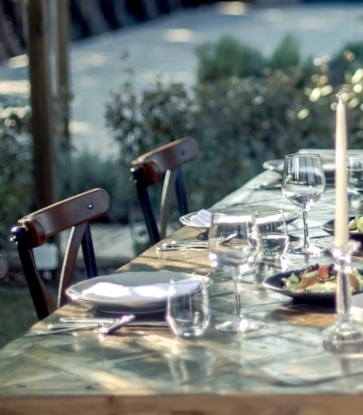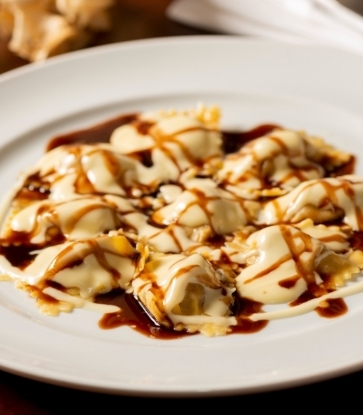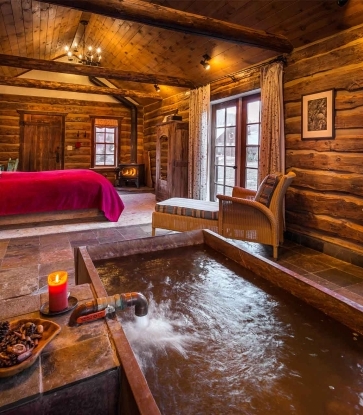Walk the quiet streets of Mérida, capital of the state of Yucatán, and you'll soon see that this charming city's heritage is a rich blend of Mayan and colonial. The downtown core is delightfully walkable and best explored on foot, but if the heat gets to be too much, you can hop in an Uber. Plan to spend a few days here and make one or two trips out of town to cenotes, ruins, or to see flamingos. Here's where to go, eat, and sleep in Mérida.

Getting To Mérida And Around
There are direct flights from a number of US cities to Cancun. From here it's a 3.5 hour drive; stop for a break after 2 hours in Valladolid, a charming colonial-era city. You can also fly to Mérida itself, with most stopovers in Houston or Mexico City.
A car is not necessary in Mérida; the best way to enjoy the lovely city center is to stroll around, and Ubers are everywhere and very inexpensive. A car is useful for day trips and—outside of busy periods like Christmas—can be rented for ~US$30/day. That said, parking in Mérida is not difficult and, if you're traveling around Yucatán, it may make sense financially to rent a car for your entire trip.
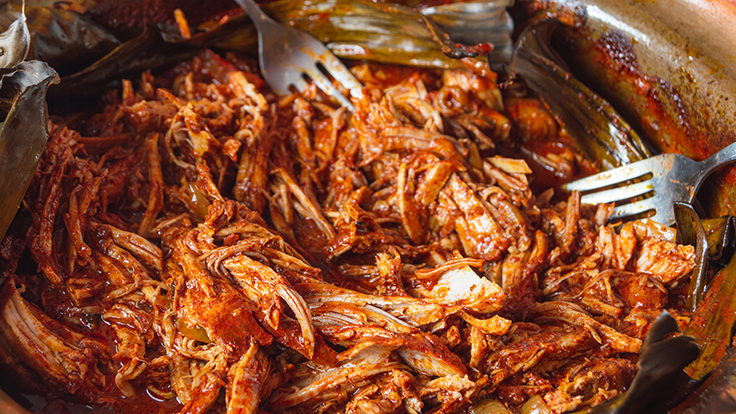
Yucatec Cuisine
Take Native Mayan techniques and ingredients, add in a dash of Lebanese, Caribbean and Western European influences (Spanish Conquistadors, Dutch traders) and you have Yucatec Cuisine—its own unique amalgam.
Prior to Spanish colonization, people on the Yucatán peninsula cooked with ingredients like beans, corn, chiles, tomatoes, squash, achiote, sour oranges, limes, turkey and other wild game and, along both coasts, a variety of seafood. When the Yucatán was colonized, ingredients such as nuts, beef, pork, and lamb, and spices and sugar from the Caribbean flowed into local kitchens.
In the 1870s, the first wave of Lebanese migrants arrived in Yucatán, bringing with them the precursor to tacos al pastor: shawarma. They also brought kibbeh and dolma, with chaya—a Swiss Chard-y leaf native to the Yucatán—used instead of grape leaves. Perhaps the most surprising ingredient in Yucatec cuisine today is Edam, aka queso de bolo, which came from Dutch traders.
Yucatec Dishes To Try
The dish you'll see on every menu is cochinita pibil. It's suckling pig rubbed with achiote paste, marinated in sour orange juice, wrapped in banana leaves, and then cooked in a pib—a sealed earthen pit that forms an airtight oven, cooking and smoking the meat (before refrigeration, this was a way to preserve meat).
Cochinita pibil is a favorite of Luis Ronzón, the executive chef at Chablé Yucatán, a luxury hotel-resort 40 minutes outside Mérida, deep in the jungle and surrounded by ruins. At Chablé, "Everything begins in prepping the pib with wood. We light the wood and surround it with stones, which retain all the heat from the wood once it's turned into charcoal. We then put the suckling pig in a metal box and cover it with the sour orange marinade. We bury the box, covering it with banana leaves and endemic trees leaves and soil, and let it cook overnight for about 14 hours. The next day we uncover the hole and will find beautifully cooked pork, super tender and juicy. You just need to add some pickled onion with habanero to make a perfect taco! Besides being super delicious, cochinita pibil is my favorite because my mom used to cook it for me in every birthday, so it’s a nice memory."
Beyond cochinita pibil, look for:
Poc'chuc: Pork marinated in in sour orange juice, grilled or cooked on a wood fire, and served with pickled red onions and usually rice and avocado. side of rice, pickled onion, refried beans, and avocado.Roasted pork filet served with sour orange, red onion, spicy chili and tomato sauce, and avocado.
Tikin xic: A firm white fish marinated in that classic mix of achiote and sour oranges, wrapped in banana leaves, and then either grilled or cooked in an earthenware oven in a wood fire. The fish turns out a beautiful deep red color from the sauce. Served with rice and/or fresh, warm corn tortillas.
Sopa de lima: A fragrant soup of lime-marinated shredded turkey or chicken, topped with crispy tortilla strips and sliced lime.
Sikil pak: A pale orange dip of toasted pumpkin seeds, cilantro, and and roasted tomato, served with totopos (corn tortilla chips) or fresh, warm corn tortillas.
Huevos motuleños: A very traditional but heavy breakfast of fried eggs on fried tortillas, topped with sliced plantains, beans, tomato sauce, a bit of cotija (or other salty, crumbly cheeses) and sometimes peas and ham.
Escabeche oriental: From Valladolid, a city in eastern Yucatán, comes this dish of turkey or chicken marinated in coriander leaves, vinegar, garlic, cumin, salt, and pepper and then grilled.
Where To Eat Yucatec Cuisine In And Around Mérida
Mercado de Santa Ana: There are a dozen vendors on the perimeter of the market offering fairly traditional Yucatec dishes are very low prices. Pull up a red plastic chair at one of the tables and taste a few different things—like cochinita pibil tacos, panuchos (fried tortilla filled with black beans, topped with tomato, pickled red onion, avocado, pickled jalapeño, tomato, and pulled chicken or turkey), juices (papaya, carrot, watermelon, even cactus). There aren't many vegetarian options here but, if you can speak a bit of Spanish, you can order many tacos with everything but the meat.
Museo de la Gastronomia Yucateca - MUGY: A lovely yellow-walled courtyard in which to sip cocktails made table-side—think mezcal with kiwi and pineapple—and peruse a menu of traditional Yucatec fare. Try salbutes (tostadas) with octopus; brazo de reina (queen's roll, a corn tamale made of chaya, filled with hardboiled egg and pumpkin seed, steamed and topped with tomato sauce); and, with Lebanese influence, kibbeh—here with meat or vegetarian.
Ixi'im (at hotel Chablé Yucatán): Start with taste of the world's largest tequila collection—3,700 bottles—before tucking in to an exquisite tasting menu (you can also order a la carte). Dishes include scallop tiradito with Yucatec citrus, smoked avocado, cabbage, and dehydrated chia or a luscious chocolate cake with smoked buttermilk ice cream and granny smith purée. The restaurant heavily utilizes ingredients local to Yucatán: the herbs and vegetables on the menu come from the hotel's own Ka'anche's—a garden of elevated beds, a Mayan horticultural technique to keep out predators; the dairy from a ranch near Tizimin, and the honey from a small apiary at the hotel and one near Progreso. Dinner Tues-Wed, Lunch and dinner Thurs-Sun.

Things To Do In Mérida
Casas Gemelas: Near the beginning of handsome promenade Paseo Montejo sit two stately homes that look so similar they're called Twin Houses—but they're not exactly the same. The 1911 Beaux-Arts mansions were built for brothers Ernesto and Camilo Cámara Zavala whose family wealth came from henequen plantations. One of the houses is for sale, and the other opened to the public for the first time in January 2021 as a museum. Walking through the grand front doors is a step back in time to Yucatán’s golden age. Eye an enormous chandelier, the first in Yucatán’s wired for electricity, as you take a shorted guided tour through the opulent rooms full of Carrara marble from Italy, stained glass windows from France, ornate plasterwork, and rich wood and gilded furniture. Montejo 495, 9am-5pm Thurs-Sun, MXN250
Palacio Canton: The city's history and anthropology museum has some very swish digs—which is most of the appeal of this small museum, housed in a pale yellow palace built in 1911 for General Francisco Canton. This grand dame was designed by Italian architect Enrico Deserti (he also designed Teatro Peón Contreras) and engineer Manuel Canton Ramos, who oversaw Casas Gemelas. The mansion-turned-museum is a mix of architectural styles: French Baroque, European neoclassical, and classical. On display are a number of Mayan artifacts, though all the placards are in Spanish. Admission is worth it for the house alone (a lavish, air-conditioned place to take a break). Montejo 485, 8am-4:40pm Tues-Sun, MXN65
Yucatán Symphony Orchestra: Walk up a grand staircase of Carrara marble and enjoy wonderful performances beneath a frescoed dome at the neoclassical Teatro Peón Contreras, built between 1900 and 1908. Performance dates varies; see Sinfonica de Yucatan, tickets from MXN150.
Cenotes: On a hot day, nothing beckons like the beautifully clear waters of a cenote, a natural pool that forms when limestone bedrock collapses, revealing groundwater. Cenotes were once water supplies for the ancient Maya, and there are estimated to be thousands across the Yucatán peninsula. Some are open-air, others underground. Many are well-touristed (and maintained) and charge a fee—some are full-on operations with life-jackets and changing facilities. A few cenotes to visit: Cenote Pool Uinic; Yaal Utzil; Yokdzonot; K'ax Ek (between Merida and Valladolid, closer to Valladolid).
Celestún Biosphere Reserve: On the far west coast of Yucatán, 1h20m drive from Mérida (or 2h by bus). Take a boat ride (approx 2h return) to see hundreds of pink flamingos (bring a zoom lens; boats remain at a safe distance so as not to disturb the birds) before cruising into the mangroves to see pelicans, egrets, and other tropical birds. Come November to April; after that, the flamingoes migrate to Río Lagartos (northern edge of Yucatán, 3h from Cancun and Mérida). Celestún is a tiny beach town with soft white sand and calm water; stay for a lunch of just-caught seafood before heading back to Mérida. If you drive, you can park at either the bridge or the beach. The bridge is closer to the flamingos. Boat drivers will approach you offering their services. Expect to pay approx. 1,600-2,000MXN for a boat that seats 5-6 people.

Where To Eat In Mérida
Méridians are really spoiled for choice when it comes to restaurants; you can find nearly anything here, from Korean barbecue to perfect Neapolitan pizza.
Soco Merida: Bakery-cafe with the best bread in Mérida, flaky French-style pastries, and brunch dishes like avocado toast, yogurt with house-made granola and seasonal fruits, and buttery egg sandwiches. A good place to get take-away sandwiches for day trips.
Mercado de Santiago: Peruse the food stalls here before ordering and taking a red metal folding chair. Options include mariscos—tacos, tortas, salbutes, etc with seafood—myriad tacos (and empanadas) at Taqueria La Lupita, and huevos motuleños. Aguas frescas, coffee, tea, and fruit juices are also on offer.
Wayan'e: Pull up a seat at breakfast or lunch for tacos on the freshest corn tortillas. You'll find all manner of meat here—carne asada, chicken, chorizo—and a couple of good vegetarian options (eggs scrambled with various vegetables, including green beans, spinach, chaya, and chives). To drink, aguas frescas like horchata, tamarind, and chaya with pineapple.
Pizzeria Raffaello: The place to go for top pizza in Mérida. Superbly chewy, blistered crusts with excellent quality toppings like fresh mozzarella, arugula, spicy salami, and mushrooms.
La Negrita Cantina: Popular casual bar-restaurant with live music, their own craft beers, and a varied menu—think ceviche, chicken fajitas, fish tacos, etc.
Pola Gelato: Divine, house-made gelato a block from Parque Santa Lucia in flavors like cardamom, chocolate with almond, orange peel, and a hint of coffee, and strawberry with lemon.

Where To Stay In And Around Mérida
TreeHouse Boutique Hotel
This astonishingly lovely hotel is not a house in a tree, but rather a courtyard-style house surrounding an impressive amount of greenery. With just 15 rooms, it retains much of its private-residence atmosphere, and the interiors combine period architecture, traditional craftsmanship, and contemporary design and amenities in a unique and memorable blend. There’s a plunge pool in the garden, as well as plenty of places to relax or socialize, indoor and out; the hotel’s bar is for guests only, serving modern cocktails featuring local flavors and ingredients.
Chablé Yucatán
Buried deep in the Yucatán jungle, tucked among Mayan ruins and sacred sites, is a more modern sort of temple, the kind built for relaxation. Guests stay in 40 airy casitas, which are designed to blend in with their jungle surroundings. Each has ample natural light, clean woodwork, and a harmonious blend of modern design with traditional Mayan architectural styles. It might feel impossible to tear yourself away from casitas' spectacular jungle views, indoor and outdoor showers, and private pool, but spend some time in the excellent spa, which is built around a natural cenote, a swimming hole with healing waters, sacred to the Maya. Come nightfall the sky is a deep, inky expanse positively heaving with stars—no light pollution here.
The food at the resort's three main restaurants is super organic, seasonal, and hyperlocal; the produce comes from the on-site Mayan gardens (ka’anche's) and a tiny apiary, which you're welcome to visit. Next to the gardens, don't miss Casita Maya, where female Mayan chefs from the neighboring villages will show you how traditional Yucateco dishes like cochinita pibil, panuchos, and sopa de lima are made.

Hero image: Palacio Municipal, Mérida. Photo © VladimirGerasimov/iStock





